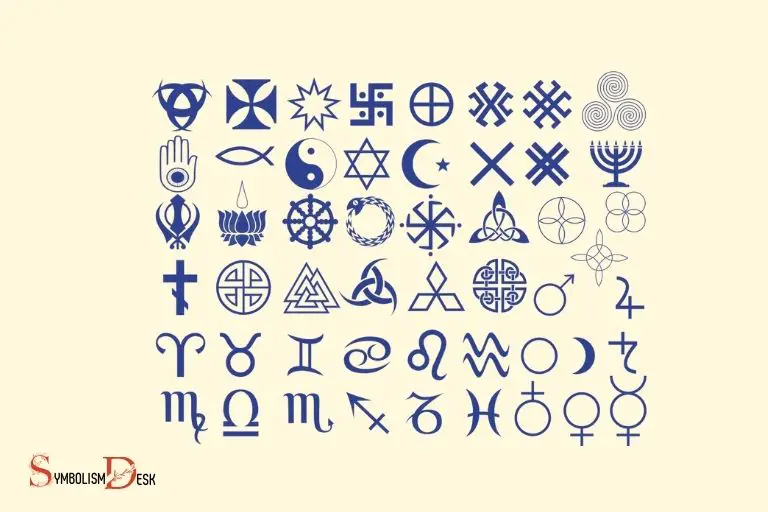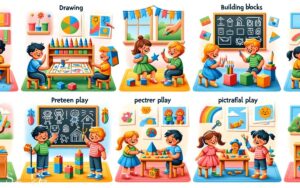Different Kinds of Symbols And Their Meaning: Daily Lives!
Symbols are a significant part of our daily lives. They are used across different cultures and contexts, symbolizing various concepts and ideas.
There are countless types of symbols, including religious symbols, mathematical symbols, traffic symbols, and computer symbols, all carrying distinct meanings.
Symbols are visual images or signs used to represent an idea, concept, or message. Religious symbols, for example, represent different religious beliefs and deities. Mathematical symbols, such as the plus (+) and minus (-) signs, represent operations or relationships between numbers.
Traffic symbols guide and instruct motorists and pedestrians on the road while computer symbols help users navigate and use digital platforms.
Overall, symbols play a critical role in various aspects of society. They facilitate communication, regulate behavior, and embody deep meanings and philosophies.
By understanding the meaning of different symbols, we can better interpret the world around us and navigate various cultural and digital landscapes.
20 Symbols Meanings of Different Kinds
| Symbol | Meaning |
|---|---|
| ! | Exclamation Point: indicates strong feelings or high volume (shouting), and often marks the end of a sentence. |
| @ | At symbol: It is used in email addresses and social media platform “handles”. |
| # | Hash: It is used in many internet applications including, but not limited to, social media platforms where they signify a Tag for content. |
| $ | Dollar Sign: It is used to denote currency, particularly in the case of the US dollar. |
| % | Percent Sign: It is used in mathematics to denote a percentage. |
| & | Ampersand: It is used to denote ‘and’. |
| * | Asterisk: It is often used to signify a footnote or to denote multiplication in mathematical equations. |
| + | Plus Sign: It is used in mathematical equations to denote addition. |
| – | Minus/Hyphen: Used in mathematics to denote subtraction, or can be used in writing to join words together. |
| = | Equal Sign: used in mathematics to show equality. |
| <> | Less than and Greater than symbols: used in mathematics, computing, and sometimes in text as brackets. |
| ? | Question Mark: It is used at the end of a sentence to denote a question. |
| / | Forward Slash: It is used to denote a division in mathematics. |
| \ | Backslash: It is often used in computing to denote a directory path. |
| [] | Square Brackets: These are often used in literature and computing to denote additional information. |
| {} | Curly Brackets: These are often used in mathematics and computing to denote a set. |
| () | Parentheses: These are used in sentences and mathematical equations to provide additional information or clarification. |
| ; | Semicolon: It is used in sentences to denote a pause longer than a comma but shorter than a period. |
| : | Colon: It is often used to denote the start of a list in a sentence. |
| ” “ | Quotation Marks: These are used to denote speech or a quotation. |
| ‘ ‘ | Apostrophe: It is used to indicate a possession or in contractions. |
| , | Comma: It is used in sentences to denote a pause. |
| . | Period: It is used at the end of a sentence to denote the end. |
Key Takeaway

Five Facts About: Symbols and Their Meanings
Cultural Symbols
Definition Of Cultural Symbols And Their Importance
Cultural symbols are signs, objects, or actions that people from a particular culture associate with a specific meaning.
These symbols are often used to represent a concept or idea that is unique to the cultural group that created them. They can include artistic expressions, gestures, and even colors that hold significant meaning or value to that particular group.
The importance of cultural symbols lies in their ability to communicate complex ideas and beliefs through non-verbal communication.
They also help preserve the identity and heritage of a cultural group, as they form a vital aspect of their history, tradition, and worldview.
Examples Of Cultural Symbols From Different Cultures And Their Meanings
Various cultures worldwide have their unique symbols with distinct meanings.
Below are some examples of cultural symbols:
- Chinese dragon: A powerful symbol of good luck, strength, and power.
- Indian lotus flower: It represents purity, enlightenment, and spiritual awakening.
- African masks: They represent the spirits of ancestors and supernatural powers.
- Celtic knots: They represent continuity, unity, and spiritual growth.
- Native american dreamcatcher: It is believed to capture bad dreams and bring good ones.
Cultural symbols are dynamic, and their meanings may change over time or vary from one culture to another. It’s essential to have a deep understanding of cultural symbols and their changing meanings to promote cultural understanding and sensitivity.
How Cultural Symbols Shape Our Perspectives And Communication
Cultural symbols have a considerable impact on how we perceive the world and communicate with others.
They help us form stereotypes and biases that shape our perceptions, attitudes, and behaviors. Understanding cultural symbols from different cultures helps promote appreciation and respect for diversity.
Additionally, cultural symbols serve as a powerful tool for communication and self-expression. By using symbols that hold meaning to specific cultural groups, individuals can convey complex ideas and emotions without using words.
This is particularly helpful in situations where language barriers exist. Cultural symbols are an essential part of our culture and heritage that hold significant meaning and value.
They allow us to communicate complex ideas and emotions effectively without the need for words and form a vital aspect of our cultural identity.
Understanding and respecting cultural symbols promote cultural sensitivity and appreciation for diversity in our world.
Religious Symbols
Different Kinds Of Symbols And Their Meaning
Symbols are essential elements in communication as they convey different meanings quickly and efficiently.
They represent ideas, objects, or relationships that would be challenging to explain in words. Symbols come in different types, including religious symbols.
In this section, we will explore the definition of religious symbols and their significance, examples of religious symbols from major religions and their meanings, and how religious symbols affect communication in religious contexts.
Definition Of Religious Symbols And Their Significance
Religious symbols are images, marks, or objects that represent concepts, beliefs, and practices of a particular religion.
These symbols have a powerful impact on religion as they help believers connect with their faith, develop a sense of community, and remind them of their spiritual journey.
The significance of religious symbols goes beyond the physical representation as they are often associated with divine or supernatural forces.
Examples Of Religious Symbols From Major Religions And Their Meanings
Christianity: The cross represents the crucifixion of jesus christ and is a symbol of salvation and eternal life.
The ichthys (fish) represents jesus christ as the savior of humanity, and the alpha and omega represent the beginning and end of all things.
Islam: The crescent moon and star represent the islamic calendar, which is based on the lunar cycle.
The calligraphy of allah represents the oneness of god, and the kaaba represents the center of islam and the holiest site for muslims.
Judaism: The star of david represents the jewish community, and the menorah represents the presence of god in the jewish temple and the triumph of light over darkness.
Hinduism: The om represents the universe’s sound and the ultimate reality, and the lotus flower represents purity, enlightenment, and rebirth.
How Religious Symbols Affect Communication In Religious Contexts
Religious symbols play a crucial role in religious communication as they enhance the understanding, expression, and reverence of religious ideas.
Moreover, they create a sense of unity and belonging among believers as they share a common understanding of their faith.
In contrast, misunderstandings or misinterpretation of religious symbols may lead to conflicts or disrespect for religious beliefs.
Understanding religious symbols is essential in appreciating the beliefs and practices of different religions. Therefore, we should respect these symbols and use them appropriately in religious contexts.
National Symbols
Definition Of National Symbols And Their Role In Patriotism
National symbols are unique representations that uphold a country’s values, culture, and history. These symbols play a critical role in patriotism in a nation, and they instill a sense of pride and belonging in citizens.
These symbols are intended to unify people and bring them together to celebrate the glory of the country.
Examples Of National Symbols From Different Countries And Their Meanings
Different countries have distinct national symbols that represent their identity.
Here are a few examples and their meanings:
- The bald eagle is the national bird of the united states, symbolizing strength and freedom.
- The maple leaf is a symbol of canada that represents unity, tolerance, and peace.
- The lion is the national animal of sri lanka, signifying bravery and strength.
- The lotus flower is india’s national flower that symbolizes purity, enlightenment, and self-regeneration.
How National Symbols Unite Or Divide People
National symbols can both unite and divide people. They can bring people together to celebrate the values that a country stands for or divide them based on their cultural background or beliefs.
However, it is essential to recognize these symbols’ significance and understand the united purpose they serve in a nation, rather than using them to create division and hatred among people.
National symbols serve as a cultural emblem that reflects its country’s history, heritage, and identity.
They have an important role in instilling patriotism and bring people together to celebrate their country’s glory. However, it is essential to recognize and respect these symbols’ significance and use them with the intention of uniting people rather than dividing them.
Universal Symbols
Definition Of Universal Symbols And Their Meanings Across Cultures
Universal symbols are images or signs that hold meaning across different cultures and contexts. These symbols are easily recognizable and are often used in different contexts, including literature, religion, and advertising.
They are considered universal because they can convey similar meanings irrespective of language or cultural differences.
They are also known as archetypal symbols because they are deeply entrenched in different cultures and societies.
Some of these symbols include:
- Heart: This symbol represents love and affection and can be used in different contexts to convey various positive emotions. It is also used to represent romantic love in many cultures.
- Circle: This symbol represents unity, infinity, and wholeness. It is often used in logos, signage, and other graphics to convey a sense of solidarity and completeness.
- Cross: This symbol represents christianity and is often used to show devotion and faith in god. It is also used in jewelry, branding, and other contexts.
- Star: This symbol is used to represent leadership, guidance, and protection. It is often used in military insignia, national flags, and commercial branding.
- Sun: This symbol represents life, warmth, and positivity. It is often used in religious and cultural contexts to convey values such as hope, renewal, and vitality.
Examples Of Universal Symbols And Their Global Significance
Different universal symbols hold different meanings around the world.
Here are some of the most common universal symbols and their significance on a global scale:
- The dove: This symbol is a widely recognized and beloved emblem of peace around the world.
- The heart: This universal symbol represents love across cultures and is a popular tattoo design and jewelry item.
- The yin yang: This symbol represents the balance and harmony between opposing forces, and it is commonly found in taoism and other eastern philosophies.
- The crescent: This symbol represents islam, and it is often used to represent the islamic faith in global contexts.
- The lotus blossom: This universal symbol represents spirituality, purity, and beauty in different cultures, including hinduism, buddhism, and chinese culture.
How Universal Symbols Aid In Global Communication
Universal symbols are powerful tools for communication as they can convey complex ideas and emotions without language barriers.
They make communication easier by reducing misunderstandings that arise due to language and culture differences.
Universal symbols are also important in marketing and advertising as they help companies to reach a wider audience with a single message.
A well-designed symbol creates an emotional connection with people across borders and cultures. Universal symbols, therefore, play a vital role in promoting global understanding and unity.
FAQ About on Different Kinds Of Symbols And Their Meaning
What Are Symbols And Their Meaning?
Symbols are visual representation of abstract concepts or ideas used to convey information, emotions or ideas.
What Are Some Common Symbols And Meanings?
Common symbols and meanings include the heart, which represents love, and the dove, which represents peace.
How Do Symbols Vary Across Cultures?
Symbols vary across cultures due to differences in beliefs, values, history and traditions.
Why Are Symbols Important In Communication?
Symbols are important in communication as they simplify complex ideas, convey meaning, and cross language barriers.
How Can Symbols Be Used In Design?
Symbols can be used in design to add meaning, evoke emotions, and make information relatable and memorable.
Conclusion
Symbols have been a part of our lives from way back and have played a significant role in our daily communication. Symbols have the power to convey complex ideas and emotions in a simple, visual form. From ancient hieroglyphics to modern-day emojis, symbols have helped us express our thoughts and feelings across cultures and languages. Google’s significance today lies in its ability to connect people with information and knowledge using symbols as a key part of its search and communication tools. With just a few clicks, users can access a vast array of symbols and discover their meanings and origins, highlighting the continued importance of symbols in our communication.
From ancient times, symbols have been utilized to express emotions, pass on messages, and capture concepts. The use of symbols has continued to be relevant in modern-day society, and it’s apparent in our daily lives.
Symbols can be found in various places, including religious institutions, corporate organizations, and social media platforms.
Knowing the types of symbols and their meanings can help us better understand the messages they convey and the impact they have on us.
It’s important to note that symbols can mean different things to different people, and their interpretation can vary depending on various factors.
Understanding the different types of symbols and their meanings is an essential skill that can help us appreciate the beauty of this form of communication.






